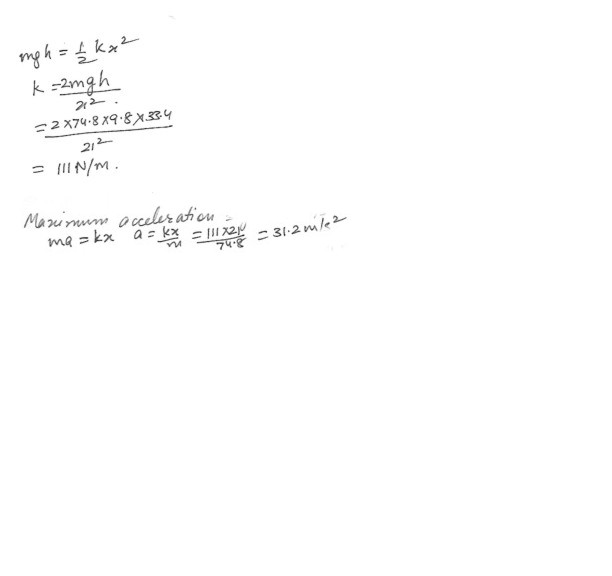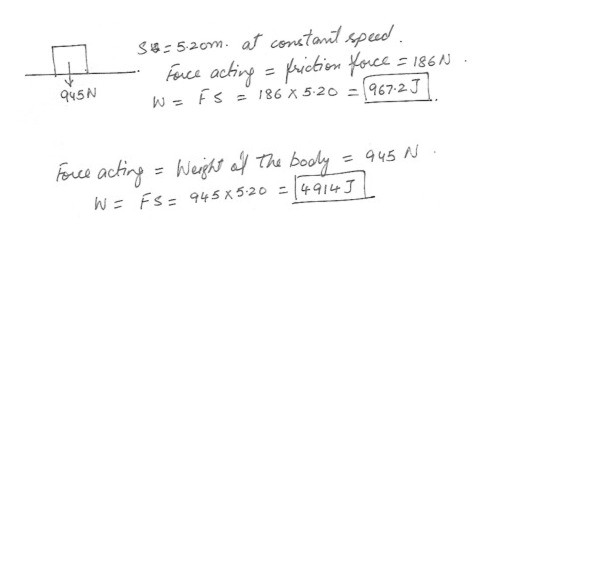Physics Work,Power & Energy Level: High School
The Conservation of Mechanical Energy
The figure at “click here” shows a skateboarder moving at v = 5 m/s along a horizontal section of a track that slanted upward by 48 degree above the horizontal at its end, which is h = 0.46 m above the ground . When she leaves the track , she follows the characteristic path of projectile motion. Ignoring friction and air resistance , find the maximum height H to which she rises above the end of the track .
Physics Work,Power & Energy Level: High School
The Conservation of Mechanical Energy
A gymnist is swinging on a high bar . The distance between his waist and the bar is 1.0 m , as the drawing shows . At the top of the swing his speed is momentarily zero , ignoring friction and treating the gymnist as if all his mass is located at hi waist , find his speed at the bottom of the swing .
Physics Work,Power & Energy Level: High School
A shot putter puts a shot (weight = 72.1 N ) that leaves his hand at distance of 1.62 m above the ground .(a) Find the work done by the gravitational force when the shot has risen to a height of 2.14 m above the ground . include the correct sign for work .
(b) Determine the change (delta PE = PE f – PE o) in the gravitational potential energy of the shot .
Physics Work,Power & Energy Level: High School
The work energy theorem and kinetic energy
A 7430 kg satellite has an elliptical orbit , as in the figure at “click here” . The point on the orbit that is farthest from the earth is called the apogee and is at the far right side of the drawing . The point on the orbit that is closest to the earth is called the perigee and is at the far left side of the figure . Suppose that the speed of the satellite is 2800 m/s at the apogee and 8550 m/s at the perigee .(a) Find the work done by the gravitational force when the satellite moves from the apogee to the perigee .
(b) Find the work done by the gravitational force when the satellite moves from the perigee to the apogee

Physics Work,Power & Energy Level: High School
Work done by a constant force

Physics Work,Power & Energy Level: High School
A bicyclist coasts down a 6.58 degree hill at a steady speed of 5.18 m/s . Assuming a total mass of 83.8 kg (bicycle plus rider) , What must be the cyclist’s power output to climb the same hill at the same speed ?
Physics Work,Power & Energy Level: High School
A shot-putter accelerates a 7.46 kg shot from rest to 13.8 m/s . If this motion takes 1.96 s , what average power was developed ?
Physics Work,Power & Energy Level: High School
A 19.6 kg child descends a slide 3.20 m high and reaches the bottom with a speed of 2.30 m/s . How much thermal energy due to friction was generated in this process ?
Physics Work,Power & Energy Level: High School
A 74.8kg bungee jumper jumps from a bridge . She is tied to a 12.4 m long bungee cord and falls a total of 33.4 m . Calculate the spring constant k of the bungee cord .(a) Calculate the maximum acceleration experienced by the jumper .

Physics Work,Power & Energy Level: High School
In the high jump , the kinetic energy of an athlete is transformed into potential energy without the aid of a pole . With what minimum speed must the athlete leave the ground in order to lift his center of mass 2.16 m and cross the bar with a speed of 0.700 m/s ?
Physics Work,Power & Energy Level: High School
In starting an exercise , a 1.72 m tall person lifts a 2.46 kg book on the ground so it is 2.33 m above the ground . What is the potential energy of the book relative to the ground ?(a) What is the potential energy of the book relative to the top of the persons head ?
(b) Calculate the work done by the person .
Physics Work,Power & Energy Level: High School
A spring has k = 92.8 N/m . Determine the work needed to stretch it from x = 3.58 cm to x = 5.88 cm, where x is the displacement from its unstretched length .
Physics Work,Power & Energy Level: High School
A 250 kg piano slides 4.04 m down a 27.2 degree incline and is kept from accelerating by a man who is pushing back on it parallel to the incline , as seen in the figure at “click here” , The effective coefficient of kinetic friction is 0.440 . Calculate the force exerted by the man .(a) Calculate the work done by the man on the piano
(b) Calculate the work done by the friction force
(c) Calculate the work done by the force of gravity
(d) Calculate the net work done on the piano

Physics Work,Power & Energy Level: High School
A 945 crate rests on the floor . How much work is required to move it at constant speed ?(a) How much work is required to move it at constant speed 5.20 m vertically ?

Physics Work,Power & Energy Level: High School
A motorcyclist (with combined mass of 200.0 kg ) heads east at a constant speed of 20.0 m/s as shown in the diagram at “click here” . Right before he enters the curve (position A) the mechanical system in the motorcycle breaks down . The motorcyclist leaves the curve at a speed of 5.40 m/s (position B) and continues to move south on a frictionless surface for a distance of 100.00 m when he hits a vertical cement block (position C)(a) Using the information provided and the corresponding laws of Physics describes, in detail , the motion of the motorcyclist between position A and C .
(b) Calculate the magnitude of the frictional force acting on the motorcycle between position A and B . Explain your reasoning .
(c) How much is the change in kinetic energy between position B and C ? What is the energy converted to at the moment of impact ?
(d) If the duration of the impact is 0.0100 s , What is the magnitude of the force exerted by the cement block on the motorcycle /passenger system ? Could a passenger survive this accident ? Explain your answer ?
(e) What magnitude of frictional force would be needed to stop the motorcycle right before impact with the cement block ?
